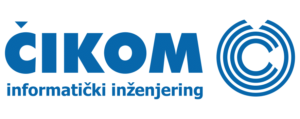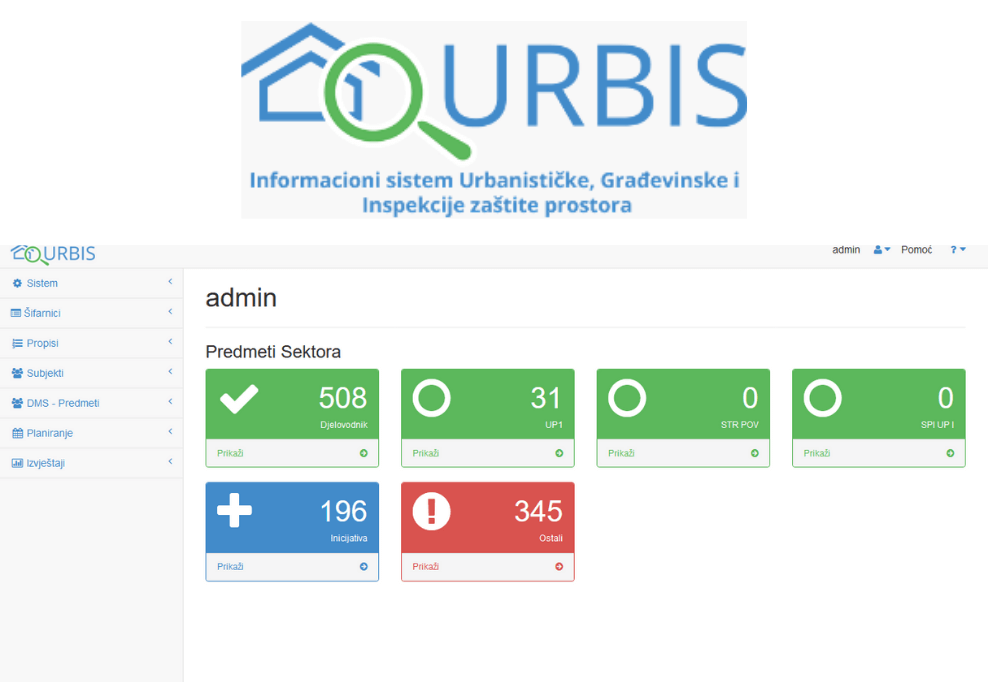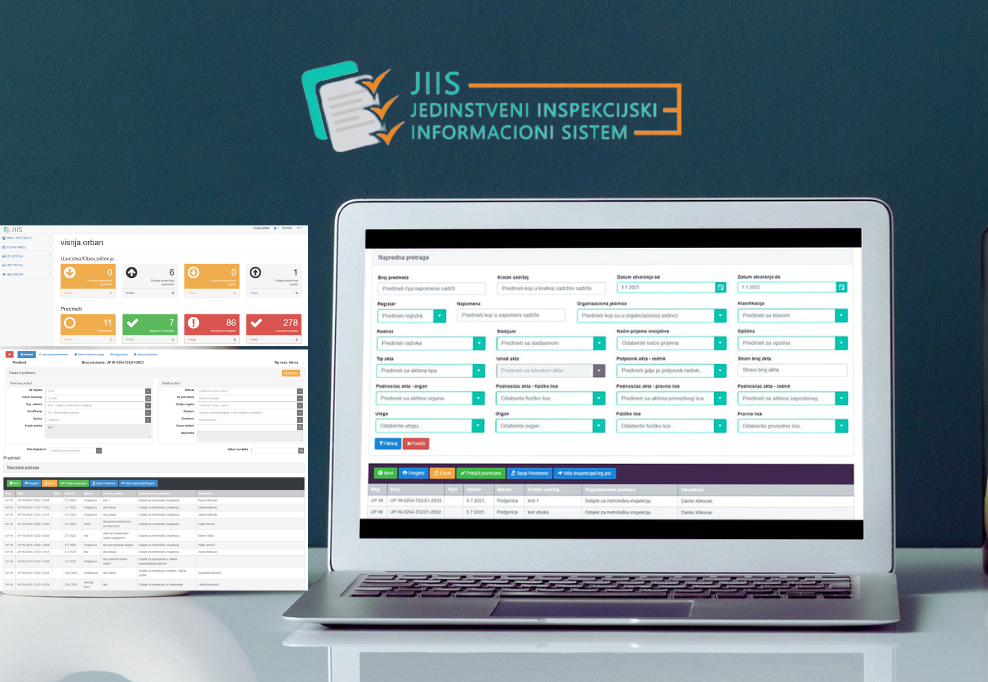URBIS is an information system intended for the automation of the Urban, Construction and Spatial Protection Inspection. The project is funded by the World Bank as part of the LAMP project (Land Administration and Management Project).
One of the most important features of Urbis is configurability, so that the IS can be relatively easily adapted and upgraded to automate business processes in all inspections. The functionalities of the system enable efficient record keeping, record generation, issuing of permits and solutions, as well as short-term and long-term planning of inspections, as well as risk assessment and management. The DMS component (electronic document management system) has been implemented in URBIS, which, precisely because of its configurability, functions in addition to the Urban, Construction and Spatial Protection Inspection in all other inspections at the level of the entire Directorate for Inspection Affairs.
The system works both in office conditions and in the field, because it is implemented as a web solution. URBIS is fully user-friendly, which comes to the forefront while working in the field as the inspector can at any time have insight into the steps that need to be carried out during the whole process of the inspection.
Basic characteristics of this information system:
- Efficiency and standardization of business processes within the Directorate for Inspection Affairs
- Automation of the inspection process
- Electronic archive of cases and documents at the level of the Directorate for Inspection Affairs
- Automation of generating different output documents (minutes, acts, permits...)
- Help with planing the inspection, as well as risk management
- Monitoring the work, workload and efficiency of inspectors at the level of the organizational unit
U sistemu su integrisani sledeći moduli:
- Inspection administration
- DMS (Document Management System)
- Inspections
- Planning and risk management
- Reports
Inspection administration
The system part of the application is a very specific module that is responsible for creating users, user roles, job hierarchy and setting access rights. This module covers the following processes:
- User administration
- Information System Security
- Codebook administration
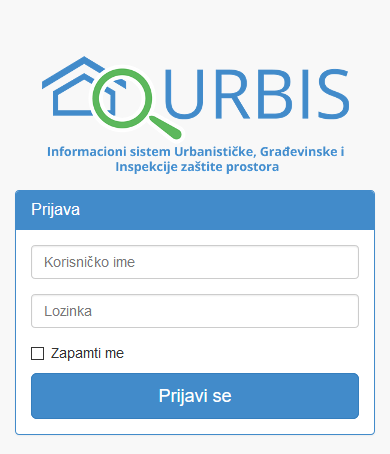
Access to this module is granted only to system administrators (users with this role)
URBIS system can be adapted to any hierarchically oriented organizational structure and, based on the positions of users in the hierarchy, define certain access rights. Access rights are assigned by user roles and work place when a new system user is created.
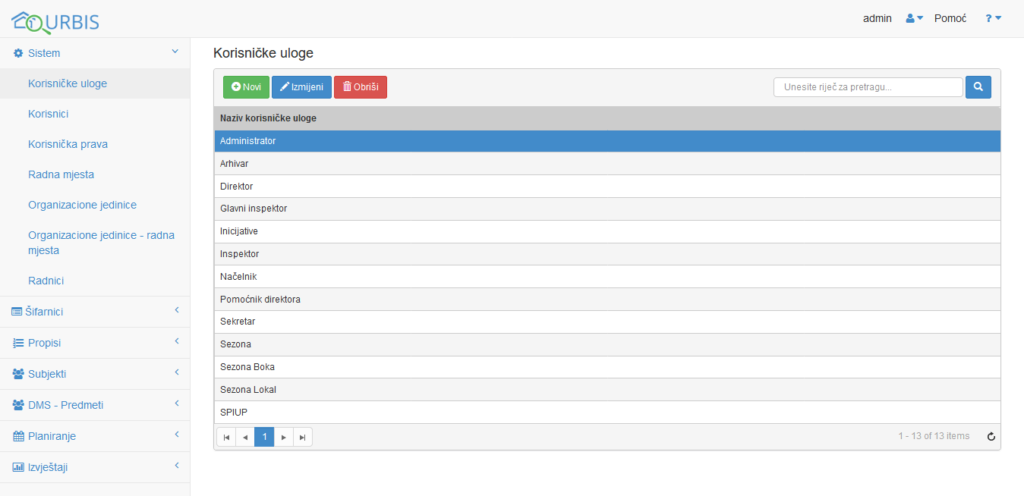
In technical sense, security of URBIS is provided by:
- appropriate authentication and authorization of system users as described in the previous paragraph
- defining rights and roles of users
- monitoring and recording activities on the system
- keeping historical tables and system logs…
- backing up data
DMS (Document Management System)
Document management system (DMS) is a component that provides monitoring of the flow of incoming and outgoing documents within the Directorate for Inspection Affairs. Business processes in this part are based on legal regulations related to office operations. DMS is not implemented as an independent component, which is often the case in practice, but its functionality has been expanded and fully integrated with inspection supervision. Thus, for example, by generating a certain document, the status of the case is automatically changed and certain inspection procedures are automatically initiated, and vice versa, by initiating inspection procedures, inspection documents are automatically generated.
Sistem omogućava autorizovanom korisniku da otvori novi predmet, ili ažurira već postojeći, u skladu sa svojim pravima pristupa sistemu. Nove predmete najčešće otvaraju Arhivari (korisnici sistema kojima je dodjeljena ova korisnička uloga) na osnovu inicijativa stranki, ali u pojedinim slučajevima otvaranje novih predmeta rade inspektori u redovnim nadzorima, jer su u tom slučaju oni inicijatori pokretanja predmeta. Svaki predmet ima svoje stadijume. Većina stadijuma se dodjeljuju automatski, a neke je potrebno ručno unijeti u nekim kasnijim fazama u životnom ciklusu predmeta.
One of the biggest problems in offices where there is no information system is the efficiency in searching for the case. It often happens in practice that when entering acts related to some previously opened case, new cases were opened, instead of joining the existing case, and in that way the procedure of working with cases was completely violated. For these reasons, advanced case search is integrated in this system, so that if the user of the system remembers any detail about the case, or the content of the digital document itself, then he can easily find the case and continue working on it.
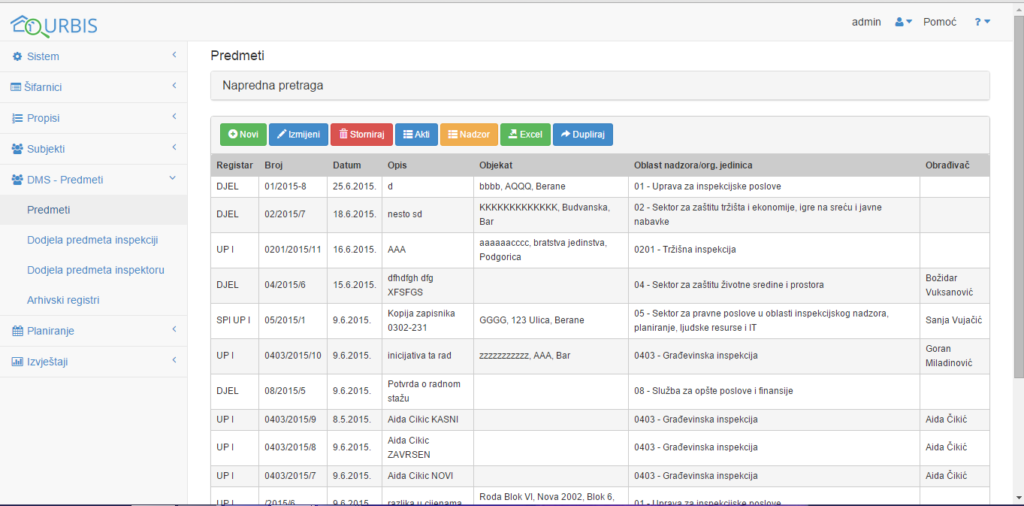
U ovom sveobuhvatnom procesu u sistem je moguće unijeti akte koji su u bilo kom mediju ili formatu. Svakom aktu moguće je pridružiti elektronsku dokumentaciju u vidu Word, PDF, Excel fajlova kao i JPG slika skeniranih dokumenata. Svaki skenirani dokument prolazi kroz proces OCR-ovanja (Optical Character Recognition), with which the text on the image is parsed into text.

There are two different types of case assignment to employees in the system, depending on the type of case opening:
- Allocation of cases opened at the initiative of the party. This means that the Archivist has already opened the case, filed the first act and determined the organizational unit, one or more (for inspection cases these are called sectors) to which the case is forwarded.
- Assignment of cases opened by inspectors in regular inspections. Here, the inspector assigns the case to himself and records it when opening the case.
U URIBIS sistemu je omogućeno i da se jedan predmet, koji je pokrenut inicijativom ili redovnim nadzorom, dodjeli u rad u više inspekcija koje mogu biti u istom ili u više različitih sektora. Kroz sistem se prati putanja interne pošiljke, tako što se u svakom trenutku zna kako dokumentacija kruži kroz organe Uprave za inspekcijske poslove i kroz koje organe i stadijume je prošla na svom putu. Eksternom pošiljkom dokumentacija se šalje van Uprave, uz vođenje računa o dostavnici i vremenu prijema.
Inspection supervision
The basis of the activities that take place within the inspections is the inspection itself. Inspection supervision is a complex set of activities by which the prescribed norms and laws are applied. The inspection component implements functionality that fully supports the work of inspectors both in the field and in office conditions.
Inspection supervision is initiated from a previously created case. The inspector may be in charge of the case through the initiative, or he can, as already mentioned, create it independently in the regular inspection control. The system provides inspectors with the ease of forming output documents from the system using data entered beforehand. These data are: roles in the system, supervisions, obligations, measures taken, procedures, payment of fines… Supervisions can be: regular, on initiative and control.
After entering all the details from one inspection, inspectors have the opportunity to generate a document consisting of predefined text using standard templates, and with small corrections through a text editor, very quickly and efficiently complete the work on documentation related to the case they are working on.

Inspection supervision is initiated from a previously created case. The inspector can be in charge of the case through the initiative, or he can create it independently in the regular inspection control.
In each tab options are arranged in the order in which the inspection itself should move: Roles on case, Supervisions, Obligations, Measures taken, Procedures, Penalty payments and Documents.
The Supervisions tab shows all initiated inspections. It is possible to add a new supervision or update an existing one at the end of the supervision itself.
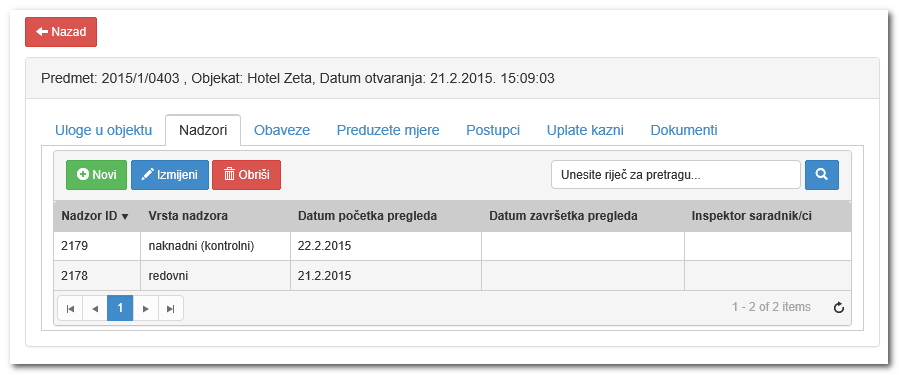
Obligations present an overview of all obligations that the inspector plans to check during the inspection.
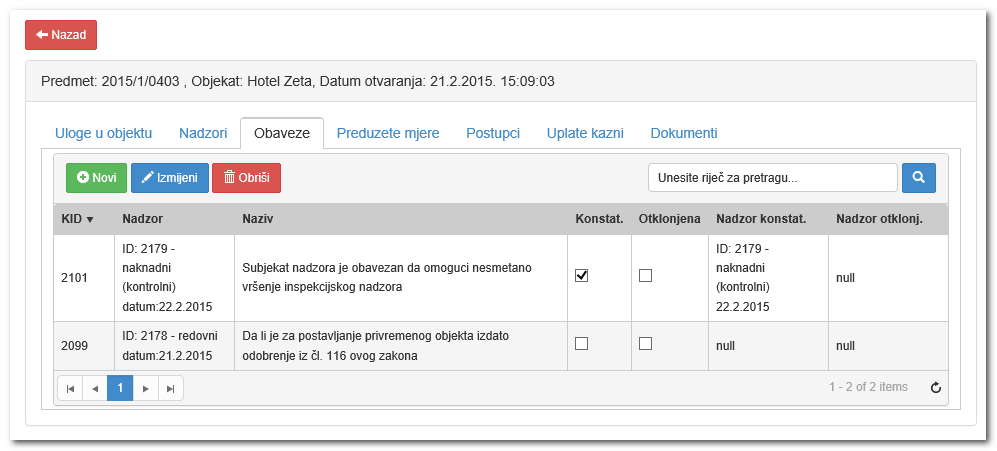
Using the Measures taken option, the inspector adds all the measures taken in the case, in relation to the appropriate supervision.
The Documents option is used by the inspector during the inspection, when he has entered all the data on the previous tabs. In this way, all the necessary data will be transferred to the document template at the moment when the corresponding document is generated.

Planning and risk management
Usefulness of an IS is reflected in the possibility of support in risk assessment, risk management and risk integration in the planning process. Planning is a module that's mainly used by inspectors and management, and through the module it's possible to create annual, quarterly and operational plans. This component enables inspectors and their superiors to create action plans and, depending on the implementation of these activities, monitor efficiency. As part of planning, risk assessment for a specific entity or facility is also integrated, so on the basis of this data, operational plans are developed.
Through this module, the process of creating annual or quarterly plans is automated. Once the codebooks are adequately filled (configured), creating plans becomes very simple by entering only the basic metadata that represents a given annual/quarterly plan. The created plans are optimized for different print formats. The operational plan is based on work planned on specific cases and is usually created on a weekly basis.
Risk assessment and management are also included in the planning, so the plans that are made can rely on the typical risks of the supervised entities, types of objects, geographical location, as well as the season in which the supervision is performed.
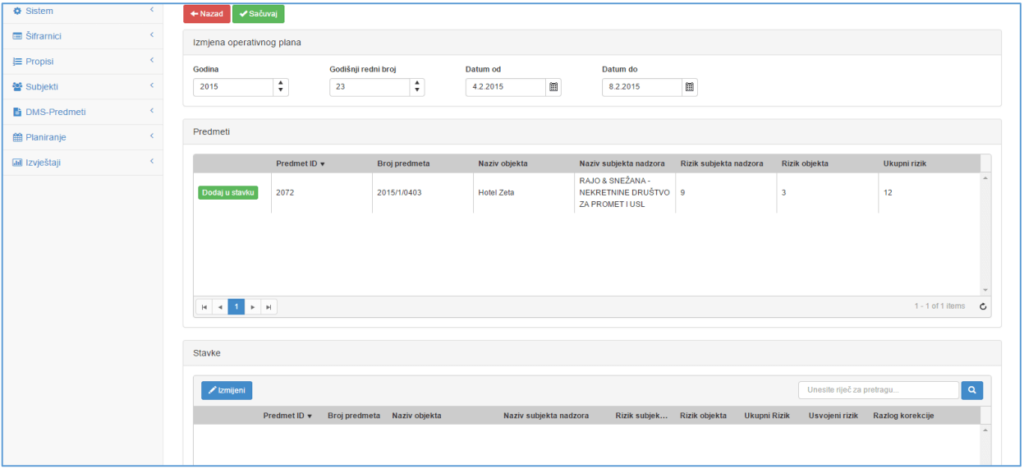
In addition to the typical risk of objects and subjects, risks are automatically calculated based on the history of previously stated irregularities from previous controls of the subjects and objects. In the end, the total risk of the object or subject is calculated as the integration of typical and historical risk, and based on it, inspectors generate plans and add priority items in planning. Defining priorities based on risk assessment is especially important in situations where inspectors are overloaded with cases and obligations, which is a very common case in practice.
In addition, as a support in planning and management, a "dashboard" is integrated, which is displayed immediately after the user logs in and its appearance is adapted to the type of user. The figure shows an example of a screen for the Assistant Director in the Environment and Spatial Planning Sector where one can immediately see the summary situation within the sector (case status, cases to be assigned, cases that are late in processing, etc.). You can also see the status of the case and the workload of individual inspectors.
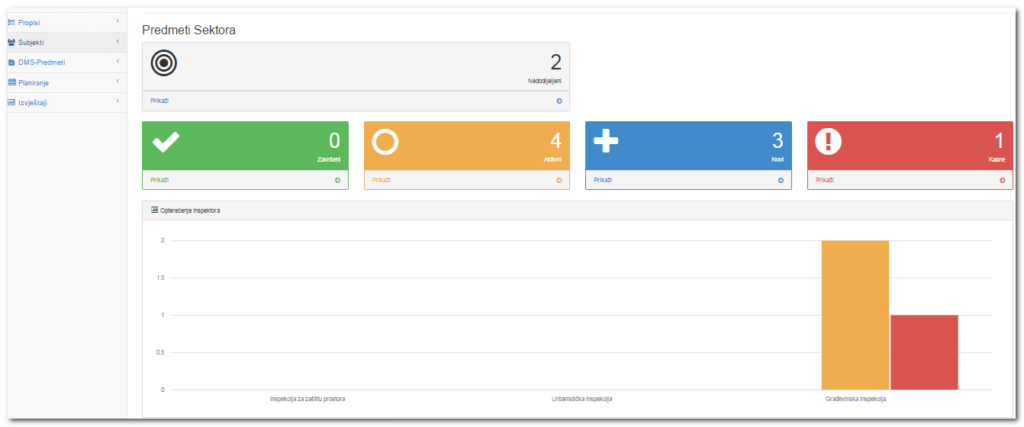
Reports
This component of the system enables the display of automated and parameterized statistical reports from the system. In addition to regular reports that are formed on a monthly, quarterly, semi-annual and annual level, it is possible to filter the data on the reports for any period of time. Reports can be printed and exported in one of the standard formats of electronic documents. The technology used to implement the report is SQL Server Reporting Services, which allow easy creation of parameterized reports based on the already existing database.
Customer service
Within URBIS, a website was created with a service for parties or citizens, where the party can obtain current information on the status of the case based on the the case number.
Technologies
- ASP.NET
- MVC
- HTML, CSS, Javascript, jQuerry
- Kendo UI
